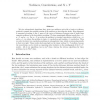Free Online Productivity Tools
i2Speak
i2Symbol
i2OCR
iTex2Img
iWeb2Print
iWeb2Shot
i2Type
iPdf2Split
iPdf2Merge
i2Bopomofo
i2Arabic
i2Style
i2Image
i2PDF
iLatex2Rtf
Sci2ools
ESA
2006
Springer
2006
Springer
Necklaces, Convolutions, and X + Y
We give subquadratic algorithms that, given two necklaces each with n beads at arbitrary positions, compute the optimal rotation of the necklaces to best align the beads. Here alignment is measured according to the p norm of the vector of distances between pairs of beads from opposite necklaces in the best perfect matching. We show surprisingly different results for p = 1, p = 2, and p = . For p = 2, we reduce the problem to standard convolution, while for p = and p = 1, we reduce the problem to (min, +) convolution and (median, +) convolution. Then we solve the latter two convolution problems in subquadratic time, which are interesting results in their own right. These results shed some light on the classic sorting X + Y problem, because the convolutions can be viewed as computing order statistics on the antidiagonals of the X + Y matrix. All of our algorithms run in o(n2 ) time, whereas the obvious algorithms for these problems run in (n2 ) time.
Algorithms | Convolution | ESA 2006 | Necklaces | Opposite Necklaces |
| Added | 22 Aug 2010 |
| Updated | 22 Aug 2010 |
| Type | Conference |
| Year | 2006 |
| Where | ESA |
| Authors | David Bremner, Timothy M. Chan, Erik D. Demaine, Jeff Erickson, Ferran Hurtado, John Iacono, Stefan Langerman, Perouz Taslakian |
Comments (0)

